External links
| Authority control |
|
|---|
| | This Stade (district) location article is a stub. You can help Wikipedia by expanding it. |
Kehdingen is the name of a landscape in the north German district of Stade on the Lower Elbe, the lower reaches of the River Elbe. It extends roughly from the mouth of the Oste in the north to the town of Stade in the south. Kehdingen is one of the Elbe Marshes. Until 1932 there was a Prussian district known as Land Kehdingen, and until 1975 there was an Evangelical-Lutheran deanery of Kehdingen with its base in Drochtersen, which was absorbed on 1 January 1976 into the deanery of Stade.

The Elbe is one of the major rivers of Central Europe. It rises in the Krkonoše Mountains of the northern Czech Republic before traversing much of Bohemia, then Germany and flowing into the North Sea at Cuxhaven, 110 kilometres northwest of Hamburg. Its total length is 1,094 km (680 mi).
Stade is a district (Landkreis) in Lower Saxony, Germany. It has its seat in Stade and is part of the Hamburg Metropolitan Region.

Bouches-de-l'Elbe was a department of the First French Empire in present-day Germany that survived for three years. It was named after the mouth of the river Elbe. It was formed in 1811, when the region, originally belonging partially to Bremen-Verden, to Hamburg, Lübeck and Saxe-Lauenburg, was annexed by France. Its territory is part of the present-day German states of Lower Saxony, Schleswig-Holstein and Hamburg. Its capital was Hamburg.
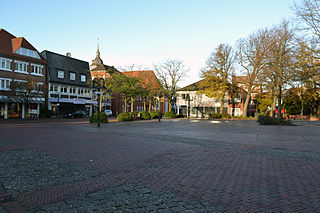
Bremervörde is a town in the north of the district (Landkreis) of Rotenburg, in Lower Saxony, Germany. It is situated on the Oste river near the centre of the "triangle" formed by the rivers Weser and Elbe, roughly equidistant from the cities of Hamburg, Bremen and Cuxhaven.

Oste is a river in northern Lower Saxony, Germany with a length of 149 km (93 mi). It is a left tributary of the Elbe.

Drochtersen is a municipality in the district Stade, in Lower Saxony (Germany). It is located 45 km north west of Hamburg.

The Province of Hanover was a province of the Kingdom of Prussia and the Free State of Prussia from 1868 to 1946.

Neuhaus an der Oste is a municipality in the district of Cuxhaven, in Lower Saxony, Germany.
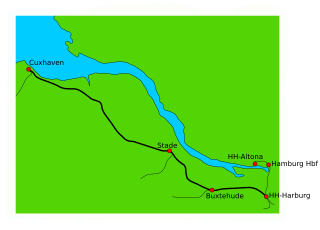
The Lower Elbe Railway, is a railway line between Hamburg and Cuxhaven in northwestern Germany, which was opened in 1881 by the Lower Elbe Railway Company. At 103.6 kilometres of length, the line runs close to the southern bank of the Lower Elbe river.

Wischhafen is a municipality in the district of Stade, in Lower Saxony, Germany.
Albert II of Brunswick-Wolfenbüttel was Prince-Archbishop of Bremen in the years 1361–1395.
The Stade Geest is a natural region of low, sandy heath (geest) in the North German Plain.

The Elbe marshes are an extensive region of marsh or polderland along the lower and middle reaches of the River Elbe in northern Germany. It is also referred to as the Lower Elbe Marsch by Dickinson and is region D24 in the BfN's list of the natural regions of Germany. The Germans refer to these polders as Marschen.

The region between the Elbe and Weser rivers forms the Elbe–Weser triangle, also rendered Elbe-Weser Triangle, in northern Germany. It is also colloquially referred to as the Nasses Dreieck or "wet triangle".

The Deutscher Olymp is a 62-metre-high elevation on the Wingst ridge within the boundary of the homonymous municipality in the district of Cuxhaven in the German state of Lower Saxony.
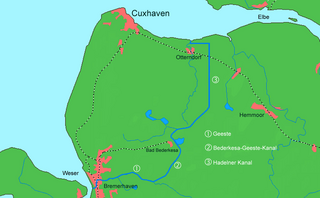
The Elbe–Weser waterway or Elbe–Weser shipping channel is a short-cut between the rivers Elbe and Weser in North Germany which is part-canal and part-river. It has a length of 54.7 kilometres (34.0 mi) and is designed for smaller coastal vessels. It includes some 60 kilometres (37 mi) of canal dykes and 45 kilometres (28 mi) of canal paths. The channel starts in Otterndorf with the Hadeln Canal, then becomes the Bederkesa-Geeste Canal from the town of Bad Bederkesa to the River Geeste, the final leg of the shipping channel, which flows into the Weser at Bremerhaven. It is owned by the state of Lower Saxony, maintained by the NLWKN from its Stade office. Today they just look after maintenance of the drainage system, because the economic element of the canal – commercial shipping which was particularly thriving in the late 1960s – declined increasingly from 1973 onwards and today hardly exists at all. Nevertheless the waterway is still used by smaller yachts as a short cut between Elbe and Weser.
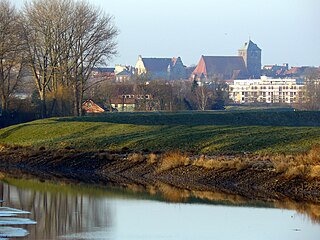
The Schwinge is river of Lower Saxony, Germany, a left tributary of the Elbe.
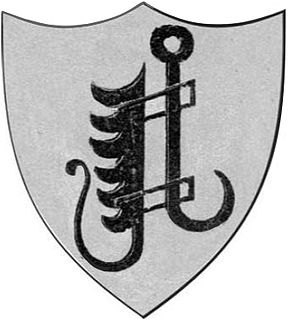
von der Decken is a Hanoverian family of German nobility. Since more than 750 years the center of the family is in a part of Lower Saxony at the south bank of the river Elbe called Kehdingen.
The Zeven Geest, which is part of the Stade Geest, is an area of sandy terrain in the northeast of the German state of Lower Saxony. It is named after the town of Zeven.

Himmelpforten Convent was founded as a monastery of nuns following the Cistercian Rule during the 13th century in Himmelpforten, in today's Lower Saxony, Germany. During the 16th century, it was converted into use as a Lutheran Damsels' Convent. The Himmelpforten Convent was founded before 1255 and finally dissolved in 1647. The convent complex was built between 1300 and 1330. After 1645 the buildings, including the abbey, increasingly decayed, until they were little by little demolished. The dilapidated abbey was demolished in 1737 and replaced by today's St. Mary's Church which partially covers the foundations of the former abbey.